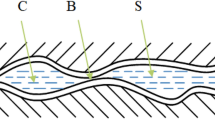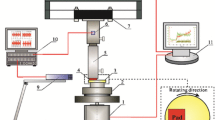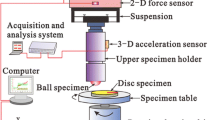Abstract
The influence of micro-groove parameters on the lubrication performance of plane friction pair is studied, by combining theoretical analysis with experiment. The theoretical model of single-groove is established, the variation rules of bearing capacity, maximum pressure and friction coefficient are obtained by changing the number, width and depth of groove. At the same time, micro-grooves with different parameters are processed on the surface of friction pair, the variation rules of the average friction coefficient, friction coefficient under different lubrication conditions are obtained in experiment, and the wear condition of friction pair surface is observed. The results show that the lubrication performance of friction pair increases, with the increase of the micro-groove width. The numerical value of the groove width–depth ratio will influence the friction pair, when the width–depth ratio is greater than or equal to 2.5, the dynamic pressure effect of micro-groove occupies a dominant position, which can improve effectively the lubrication performance. When the width–depth ratio is less than 2.5, the micro-groove will have a negative impact, resulting in the increase of friction coefficient. The groove density will also influence the lubrication performance of friction pair, when the density is less than 10%, the spacing between the micro grooves is too large to collect wear particles, when the density is greater than 20%, the surface roughness of friction pair will be affected, leading to the increase of friction coefficient. The optimal parameters of the micro-groove obtained are as follows: the optimal density is 10%, the width is 0.1–0.2 mm, and the ratio of width to depth is greater than or equal to 2.5. In addition, by comparing the variation of friction coefficient under different lubrication conditions, it can be concluded that adding solid lubricant in lubricating oil, can not only reduce the friction coefficient value, but also decrease the variation fluctuation of friction coefficient.


















Similar content being viewed by others
References
Grabowski A, Sozańska M et al (2018) Laser surface texturing of Ti6Al4V alloy, stainless steel and aluminium silicon alloy. Appl Surf Sci 461:117–123
NaiMing Lin, RuiZhen Xie, Guo JunWen et al (2016) Improvement in tribological property of 316 stainless steel via surface texturing-plasma nitriding duplex treatment. China Surf Eng 29(02):58–68
Guorong W, Long J, Xia He et al (2015) Experimental verification of simulation analysis method on antifriction and lubrication performance of surface texture. LubrEng 40(08):81–85
Tala-Ighil N, Fillon M (2015) A numerical investigation of both thermal and texturing surface effects on the journal bearings static characteristics. TribolInt 90:228–239
Ryk G, Etsion I (2006) Testing piston rings with partial laser surface texturing for friction reduction. Wear 261(7/8):792–796
Martin N, Peter P, Marcel K (2017) Finite element analysis of tool stresses, temperature and prediction of cutting forces in turning process. Solid State Phenom 261:354–361
Jianliang Li, Dangsheng X, Jihui D et al (2010) Effect of surface laser texture on friction properties of nickel-based composite. TribolInt 43(5–6):1193–1199
Yuan S, Lin N, Zou J et al (2019) Effect of laser surface texturing (LST) on tribological behavior of double glow plasma surface zirconizing coating on Ti6Al4V alloy. Surf Coat Technol 368:97–109
Rao TVVLN, Rani AMA, Nagarajan T et al (2014) Analysis of couple stress fluid lubricated partially textured slip slider and journal bearing using narrow groove theory. Tribology Int 69:1–9
Wang LL, Guo SH, Wei YL, Yuan GT, Geng H (2019) Optimization research on the lubrication characteristics for friction pairs surface of journal bearings with micro texture. Meccanica 54(8):1135–1148
Zhang Zhao Lu, Wenzhuang HY et al (2019) Research on optimal laser texture parameters about antifriction characteristics of cemented carbide surface. Int J Refract Metal Hard Mater 82:287–296
NecpalPokornyKuruc MPM (2017) Finite element analysis of tool stresses, temperature and prediction of cutting forces in turning process. Solid State Phenom 261:354–361
Yu Haiwu, Wang Xiaolei, Zhou Fei (2010) Geometric shape effects of surface texture on the generation of hydrodynamic pressure between conformal contacting surfaces, Tribology Letters 37. 123–130
Shinde AB, Pawar PM (2017) Multi-objective optimization of surface textured journal bearing by Taguchi based Grey relational analysis. TribolInt 114:349–357
Kumar V, Sharma SC (2018) Influence of dimple geometry and micro-roughness orientation on performance of textured hybrid thrust pad bearing. Meccanica 53(14):3579–3606
Urbaniak W, Kaldonsk T et al (2015) Impregnated porous bearings textured with a pocket on sliding surfaces: comparison of h-boron nitride with graphite and molybdenum disulphide up to 150 °C. Meccanica 50(5):1343–1349
Scaraggi M, Mezzapesa FP, Carbone G et al (2013) Friction properties of lubricated laser-micro textured-surfaces: an experimental study from boundary-to hydrodynamic-lubrication. TribolLett 49:117–125
Kummel D, Hamann-Schroer M, Hetzner H et al (2019) Tribological behavior of nanosecond-laser surface textured Ti6Al4V. Wear 422–423:261–268
Cupillard S, Glavatskih S, Cervantes MJ (2008) Computational fluid dynamics analysis of a journal bearing with surface texturing proceedings of the institution of mechanical engineers, part J. JEngTribol 222(2):97–107
Liu Q (2019) Effect of laser micro-texture and graphite coating on antifriction and antiwear properties of aluminum alloy. Xiangtan University Master Thesis, 2019
Acknowledgement
This work was supported by the grant from China Postdoctoral Science Foundation funded project (No. 2017M612304), Shandong Provincial Postdoctoral Innovation Foundation (No. 201701016), Qingdao Postdoctoral Research funded project, and Study broad Fund Sponsored by Shandong province government and Shandong University of Science and Technology.
Author information
Authors and Affiliations
Corresponding author
Ethics declarations
Conflicts of interest
The authors declare that they have no conflict of interest.
Additional information
Publisher's Note
Springer Nature remains neutral with regard to jurisdictional claims in published maps and institutional affiliations.
Rights and permissions
About this article
Cite this article
Wang, L., Zhao, X., He, M. et al. Effect of micro grooves on lubrication performance of friction pairs. Meccanica 56, 351–364 (2021). https://doi.org/10.1007/s11012-020-01295-y
Received:
Accepted:
Published:
Issue Date:
DOI: https://doi.org/10.1007/s11012-020-01295-y




